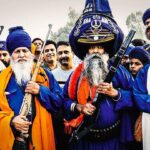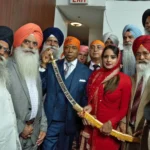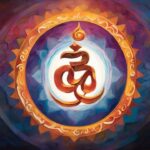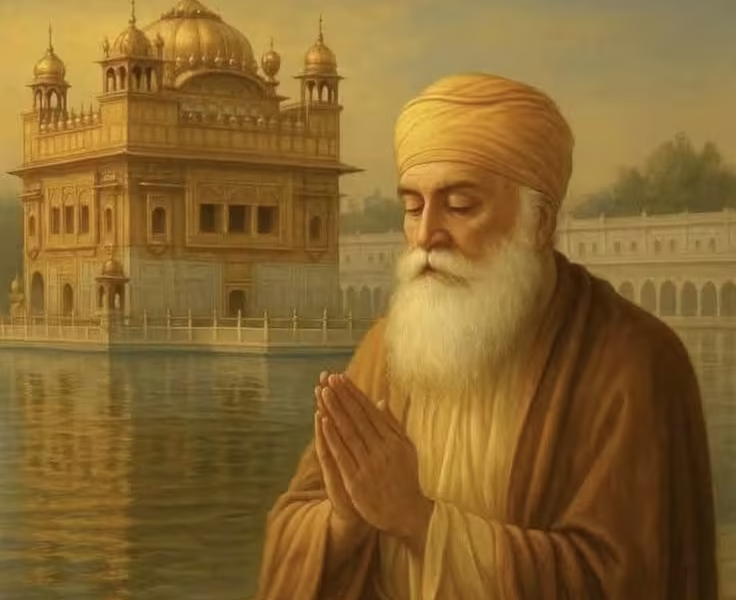The Sikh religion was established by Guru Nanak at the end of the fifteenth century in the Punjab region of the northern Indian subcontinent and modern-day Pakistan. Of the ten Sikh Gurus, he was the first. On April 13, 1699, Guru Gobind Singh, the tenth, formalized its practices. To establish Khalsa fauj (), he baptized five Sikhs with various socioeconomic origins from various regions of India. He was then received into the Khalsa fold by the five Beloved Ones, the Paj Pir. This gives the Khalsa order a roughly 500-year history. According to historical theory and analysis, Sikhism originated during the early medieval Bhakti movement and also followed many Muslim invasions of the Hindu society under the Mughal era. This took place between 1526 and 1857 AD, particularly in the area of North India. In the Undivided Punjab region, the eldest son of every Punjabi Hindu family was nominated and represented as a Sardar, and they defended their families and Indic communities from the tyranny and cruelty of Muslim rulers.
Although Punjab’s history and the sociopolitical climate in the Indian subcontinent’s northwest during the 17th century are strongly related to the history of the Sikh faith. Because Sikhism affected Mughal political successions while praising sufi saints from Islam, it clashed with Mughal rules from the time that the Mughal Emperor Jahangir (r. 1605–1627) ruled over India. Several prominent Sikhs were murdered by the Mughal emperors for defying their commands and speaking out against the oppression of Sikhs. Among the ten Sikh gurus in total, two, Guru Arjan Dev and Guru Tegh Bahadur, were tortured and killed, and many other highly regarded individuals, including the seven and nine-year-old sons of Guru Gobind Singh, were also ruthlessly murdered. Mughal kings tortured and executed prominent Sikhs (such as Banda Bahadur (1716), Bhai Mati Das, Bhai Sati Das, and Bhai Dayala) for defying their commands and resisting the persecution of Sikhs and Hindus. Sikhism, therefore, militarised itself to challenge Mughal authority. The Sikh Confederacy, founded by the Misls, and the Sikh Empire, ruled by Maharajah Ranjit Singh (1792–1839), were notable for their tolerance and pluralism of religions, with Christians, Muslims, and Hindus holding positions of authority. The founding of the Sikh Empire in 1799 is frequently cited as the political peak of Sikhism. From 1799 to 1849, the Sikh Empire expanded to include Kashmir, Ladakh, and Peshawar. Many rural Hindu and Muslim converts became Sikhs. From 1825 until 1837, Hari Singh Nalwa, who served as the Sikh army’s supreme commander throughout the northwest Frontier, extended the Sikh Empire’s borders right up to the Khyber Pass’s mouth.
The secular government of the Sikh Empire incorporated ground-breaking political, economic, and military reforms. Chief Khalsa Dewan and Shiromani Akali Dal, both of which are led by Master Tara Singh, were among the Sikh organizations that fiercely opposed India’s division because they believed that the potential existence of Pakistan would invite persecution. Heavy fighting between Sikhs and Muslims in Punjab in the months before India’s 1947 partition resulted in the effective religious migration of Punjabi Sikhs and Hindus from West Punjab, which was mirrored by a comparable religious exodus of Punjabi Muslims from East Punjab. Nowadays, the majority of Sikhs reside in Punjab, India, where they make up over 60% of the state’s population.
Master Nanak (1469 – 1539 CE)
The founder of Sikhism, Guru Nanak Dev (1469–1539), was born to Mehta Kalu and Mata Tripta in the village of Talwandi, now known as Nankana Sahib, close to Lahore. His father, Mehta Kalu, worked for the government as a patwari, or land revenue accountant. Mata Tripta was Nanak’s mother, and Bibi Nanki was his only sibling. Guru Nanak Dev Ji appeared to have developed an inquisitive and critical mind at a young age. As a little child, he refused to wear the ritualistic “holy” thread known as a Janeu and said that he would wear the actual name of God in his heart as protection instead. Bibi Nanki recognized the Light of God in her brother as a little child, but she kept this observation a secret. She is regarded as Guru Nanak’s original pupil.
The author is Guru Angad (1504 – 1552 CE)
Instead of one of his sons, Guru Nanak decided to hand down the guruship to his disciple Lehna in 1538.
Guru Angad, also known as Bhai Lehna, succeeded Guru Nanak. On March 31, 1504, in the Punjabi village of Harike in the Ferozepur district, Bhai Lehna was born. He was the son of Pheru, a modest shopkeeper. Mata Ramo was the name of his mother (also known as Mata Sabhirai, Mansa Devi, or Daya Kaur). His grandfather, Baba Narayan Das Trehan, lived in the Matte-di-Sarai neighborhood of Muktsar. Bhai Lehna was influenced by his mother to start worshipping Durga (A Hindu Goddess). He once led some Hindu worshippers to the Jwalamukhi Temple.








